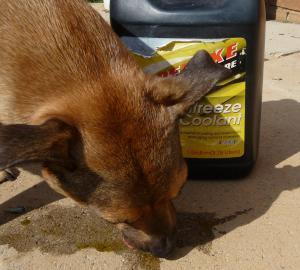Antifreeze Toxicity in Pets
- posted: Sep. 10, 2016
 What Happens When a Pet Drinks Antifreeze?
What Happens When a Pet Drinks Antifreeze?
Most of us know that antifreeze is toxic to pets, but what actually happens when a pet drinks antifreeze? Antifreeze typically contains ethylene glycol, a sweet tasting alcohol that freezes at very low temperatures. The sweet taste can be attractive to dogs and cats who may lick spills or drink from puddles or open containers of antifreeze. Even small amounts can be highly toxic—one to two teaspoons can be lethal to a ten pound cat.
Once ethylene glycol enters the body, it is absorbed from the intestinal tract within a few hours where it is metabolized by the liver and kidneys to several toxic by-products. An enzyme called alcohol dehydrogenase is responsible for most of the metabolism. These breakdown products are acidic, changing the pH of the blood and damaging cells in the body. Most notably, the toxic byproducts damage cells in renal tubules in the kidneys and lead to complete kidney failure.
Initially, pets may act drunk with staggering and/or becoming very lethargic. Pets may also vomit and may experience increased drinking and urination. Complete shut-down of the kidneys occurs within 12-24 hours in cats and within 36-72 hours in dogs. Pets in kidney failure often produce little to no urine and will be lethargic, dehydrated, will not want to eat, may have vomiting and ulcers in the mouth and may even have seizures. The kidneys may become swollen and painful.
Early on, the presence of a specific form of calcium oxalate crystals in the urine may be diagnostic for ethylene glycol ingestion, but there are few other specific signs of antifreeze toxicity. If a pet was observed or suspected of drinking or licking antifreeze, immediate veterinary care is important.
The more time that elapses after ingestion of antifreeze, the worse the prognosis. Because the toxins act so rapidly, there is little time to prevent absorption or to reverse kidney damage once it has begun. However, if the patient is treated early, he or she may recover. Treatment focuses on trying to reduce further absorption by inducing vomiting if the dog or cat presents within one to two hours of ingestion of the toxin and if he or she is not exhibiting neurologic symptoms then treating with either a commercially available antidote known as 4-methylpyrazole or 4-MP, or, intravenous ethanol (alcohol). Both alcohol and 4-MP bind faster to the alcohol dehydrogenase enzyme than ethylene glycol molecules thereby preventing breakdown of the antifreeze to toxic compounds. Intravenous fluids and other supportive care are also necessary and patients need to be hospitalized and treated over several days.
If a dog or cat is already in kidney failure, the antidote does not work and the patient usually cannot be saved, though supportive care may be attempted. Permanent kidney damage often results, and the prognosis for most cats and dogs who ingest antifreeze is very poor unless they are treated very shortly after ingestion.
Many companies have added compounds to antifreeze to make them taste bitter and therefore be less attractive to pets and children. Propylene glycol, a less toxic alternative can also be used as a coolant and is found in many pet-safe antifreeze products. However, antifreeze remains a concern for pet owners and can be fatal if not detected or treated. Keep antifreeze out of reach of any pets or children and clean up spills immediately and thoroughly. If you suspect an animal has ingested even a small amount of antifreeze, seek emergency care as ethylene glycol ingestion is often fatal.
This blog brought to you by the Patton Veterinary Hospital serving Red Lion, York and the surrounding communities.
FYI: The accompanying photo was staged--Frankie is drinking corn syrup, not antifreeze!
Location
Patton Veterinary Hospital
425 E Broadway
Red Lion, PA 17356
